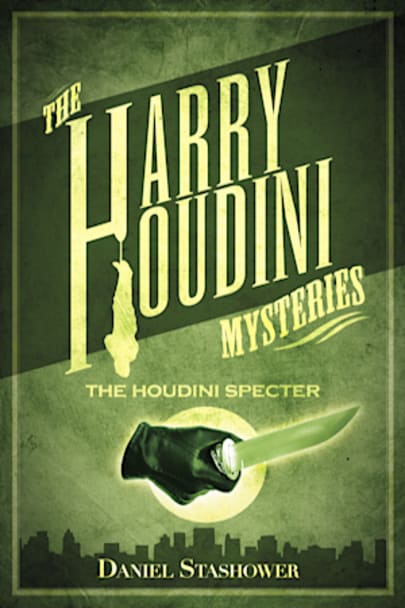The Great Harry Houdini is still struggling to make a name for himself in turn-of-the-century New York. He sees an opportunity for glory in exposing the tricks of the medium Lucius Craig – if only he can work out how the medium managed to conjure a “spirit” while tied to a chair by Houdini himself or how the apparition was able to stab an audience member to death and then disappear!The third … disappear!
The third thrilling adventure for the legendary magician from award-winning author Daniel Stashower!
more



According to an inside-cover blurb, Harry Houdini has appeared as a character in a number of crime novels over the years. That may be, but I’ve only seen him referred to as a magician and escape artist in stories featuring impossible crimes, not as an active character. When I ran across a copy of THE HOUDINI SPECTER and saw that it dealt with Harry Houdini solving a seemingly impossible crime, I had to read it.
I’m glad I did. It’s an entertaining read.
Narrated by Houdini’s brother, Dash Hardeen, who is both a magician and Harry’s booking agent, the story takes place in New York in 1898. Houdini has yet to attain the success and fame he would in the future, although to hear him tell it, he’s famous all over the world. Compared with his ego, Hercule Poirot, Nero Wolfe, and Sir Henry Merrivale are paragons of humility.
A newspaperman named Biggs, a longtime friend of Dash’s, introduces the brothers (whose real last name is Weiss) to his old friend Kenneth Clairmont. Clairmont is the son of the late Jasper Clairmont, the shipping magnate who apparently took his own life by shooting himself in his locked, private study. Kenneth’s mother, Augusta Clairmont, has since become enchanted with and by a spiritualist named Lucius Craig, whom she has taken into the family home as her guest, along with Craig’s young daughter Lila. Certain that Craig is a charlatan and confidence man out to take advantage of his mother’s hospitality and wealth, Kenneth enlists the aid of Harry and Dash to expose him.
At the Clairmont home, in addition to Craig and Mrs. Clairmont, Harry and Dash meet Edgar Grange, the family lawyer; Dr. Wells, Augusta’s physician; and Sterling Foster, Mrs. Clairmont’s drunken brother. After a sumptuous dinner, the party adjourns to a room Craig has decked out as a “seance chamber.” Once everyone is seated around a table, Craig goes into his act, which apparently includes clairvoyance. Harry, unable to restrain himself, proceeds to demonstrate how it’s done. Craig indignantly insists that Houdini knows nothing of the spirit world, and Mrs. Clairmont takes his side. Grange and Wells align themselves with Houdini both as disbelievers and as potential suitors for the wealthy widow.
Unruffled and undeterred, Craig plunges on into the seance. To prove the veracity of his spiritualism, he invites Houdini to tie his hands to the arms of the chair in which he is sitting. Harry, master of escapes, trusses him so as to render impossible the chance of Craig’s freeing himself. The room goes dark, and eventually everyone seated at the table, their hands and feet touching so as not to break “the spirit circle” necessary to invoke manifestations from the other side, witnesses the frightening spectacle of a green “glowing apparition” brandishing a knife. Is this the ghost of Jasper Clairmont? Both Harry and Dash leap from their seats to grapple with it as Kenneth calls for light. Harry and Dash collide with one another, the lights come on, and Edgar Grange, gasping, “Jasper!” slumps forward in his seat, a knife in his back.
The door to the room was locked before the seance began. It is subsequently determined that the windows were fastened, too. Unless a ghost committed the murder of Edgar Grange, one of the seven remaining people clustered around the table must have done it. But how—since their hands and feet were touching?
Daniel Stashower is to be commended. Harry Houdini is not portrayed as the infallable, dignified detective. His brother Dash is not portrayed as the idolatrous but otherwise inept Watson. (In fact, in this book, at least, Dash does more to arrive at a solution—and a somewhat startling one at that, given its motivation—than does Harry.)
If I have any complaint, it’s that the book is not a strictly fair-play whodunit/howdunit by Golden Age standards. Nevertheless, it’s such delightful and fast-paced reading that I can highly recommend it. It’s the third in a series that includes THE DIME MUSEUM MURDERS and THE FLOATING LADY MURDER, both of which I intend to track down.
© 2007 Barry Ergang